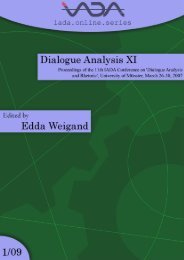Dialogue in and between Different Cultures - International ...
Dialogue in and between Different Cultures - International ...
Dialogue in and between Different Cultures - International ...
You also want an ePaper? Increase the reach of your titles
YUMPU automatically turns print PDFs into web optimized ePapers that Google loves.
Contrastive Analysis of English <strong>and</strong> Polish Military Texts 93<br />
documents were counterparts or translations of the Soviet ones. As a result, it is<br />
possible to f<strong>in</strong>d cases of awkward pleonasms or word comb<strong>in</strong>ations <strong>in</strong> them.<br />
However, because the <strong>in</strong>vestigated Polish samples (1, 3 <strong>and</strong> 6) represent a<br />
mature <strong>and</strong> well thought-out style of writ<strong>in</strong>g, I could not f<strong>in</strong>d much evidence that<br />
would support that popular stereotype. There is only one <strong>in</strong>stance of such a slip. It<br />
appears <strong>in</strong> the passage on load<strong>in</strong>g <strong>and</strong> unload<strong>in</strong>g of materiel. The Polish word<strong>in</strong>g<br />
is wymiary gabarytowe, which can be translated <strong>in</strong>to English as ‘dimensional<br />
measurements’, which constitutes a pleonasm.<br />
7. Grammaticaliz<strong>in</strong>g<br />
As far as contrastive analysis <strong>in</strong> terms of grammar resources <strong>in</strong> the <strong>in</strong>vestigated<br />
texts is concerned, is should be noted that while the Polish <strong>and</strong> English<br />
counterparts feature a high frequency of modal constructions <strong>and</strong> absence of<br />
deixis, the passive voice is more frequent <strong>in</strong> the exam<strong>in</strong>ed English corpus. At the<br />
same time, Polish logistic texts are characterized by a greater quantity of impersonal<br />
constructions, e.g. należy dążyć / wykorzystać / rozmieszczać etc. (“one<br />
should strive / employ / deploy”) or dopuszcza / określa się, że etc. (“it is allowed<br />
/ estimated that”). The Polish equivalents of English modal verbs play an equally<br />
significant role <strong>in</strong> the contrasted Polish documents. There are numerous cases of<br />
the use of the Polish equivalent of ‘should’ to suggest the desired course of<br />
actions, e.g. “Material equipment which is to be transported by air should be<br />
moved to the field stores by wheeled means of transport” (Sample 1). Furthermore,<br />
Polish logistic manuals present a greater number of imperative mood<br />
clauses which enhances its <strong>in</strong>structive character. Moreover, while both the NATO<br />
<strong>and</strong> Polish texts are marked by a relatively high frequency of circumstances of<br />
manner, <strong>in</strong> its quality aspect, the exam<strong>in</strong>ed Polish documents show an <strong>in</strong>creased<br />
number of circumstances of temporal location, <strong>and</strong> the English military texts<br />
feature many <strong>in</strong>stances of the location circumstantial, <strong>in</strong> its spatial aspect.<br />
The avoidance of deictics, the excessive use of the passive voice, <strong>and</strong><br />
impersonal constructions result from the fact that the documents <strong>in</strong> both<br />
languages are written by organizations of higher authority. Consequently, it is not<br />
necessary for their writers to outwardly <strong>in</strong>struct their reader. Instead both Polish<br />
<strong>and</strong> English writers can allow more implicit language for the texts.<br />
8. Letter layout<br />
In general terms, the letter layouts <strong>in</strong> the contrasted text repertoires are very<br />
different from each other. First of all, the format of NATO documents is<br />
established for all services by separate documents issued by the Military Agency<br />
for St<strong>and</strong>ardization. Polish documents used to have st<strong>and</strong>ards only for some<br />
official documents, e.g. orders, memor<strong>and</strong>a, <strong>and</strong> reports, whereas layouts of<br />
manuals followed their authors’ imag<strong>in</strong>ation. This is why, while the NATO texts



